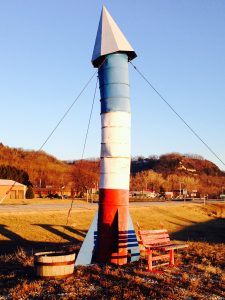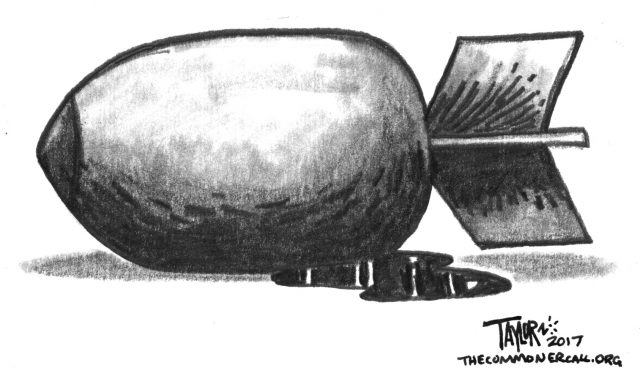
By Abrahm Lustgarten
ProPublica (12/18/17)
IT WAS A SECRET wartime project, with a code name and an urgent mission: develop a more powerful bomb, one that could be mass produced in time to fend off the German forces ravaging Europe. It was 1940.
British chemists toiled with a tripod-shaped bond of nitrogen and oxygen molecules linked by carbon and hydrogen they referred to as “research department explosive” — a substance one and a half times as powerful as TNT, but so delicate it had to be mixed with beeswax to be stable and pliable enough to fit into warheads. Even then, it wasn’t good enough. Only 70 tons could be made in a week. Defeating the Nazis would require more.
In 1941, American chemists accomplished what their British counterparts could not. John Sheehan and Werner Bachman, University of Michigan researchers, worked with a team of government scientists to invent a new chemical process that made it possible to manufacture what Sheehan described as “super-explosives.” Best, enormous quantities could be churned out quickly — 500 tons a day, an assembly line for destructive might.
The Americans called the new formula RDX, and it transformed weapons overnight. RDX enabled the bazooka — the world’s first hand-held anti-tank rocket launcher — to pierce armor. RDX was packed into 10,000-pound underwater bombs dropped by British airplanes to blow up German river dams and disrupt the country’s hydropower in the critical Dambuster campaign. It was even surreptitiously soaked into firewood that would later explode in the furnaces of German locomotives.
By many estimates, RDX was critical to victory in World War II. It also spawned the greatest period of military manufacturing — and perhaps the largest arsenal — in the history of the planet. For most of the last 74 years, a single industrial plant in rural Tennessee served as America’s RDX factory and it produced as much as 40 million pounds of white crystalline powder each month that fueled the vast carpet bombing of the Korean peninsula, and then later, America’s involvement in Vietnam.

The explosive compound RDX helped make America a superpower. And it’s been poisoning American citizens for decades.
*****
RDX is “a mighty instrument,” Sheehan wrote, “that may well have transformed the nature of modern warfare.”
But RDX, a powerful triumph of military ingenuity, has had an unwanted second life — as an unusually persistent pollutant poisoning the American homeland.
At bomb-making plants and ordnance testing ranges across the United States, RDX has spread into the soil and contaminated water supplies. The first signs of trouble emerged at Army bomb-packing plants in Tennessee, and then near Grand Island, Nebraska, where drinking water aquifers were found to be contaminated with the explosive. By 1990, the U.S. Environmental Protection Agency had designated RDX a possible human carcinogen. Near Salt Lake City, people who grew their food with RDX-contaminated water alleged it caused their cancers. Then RDX damage was identified in Virginia, California, and even on one of the East Coast’s iconic vacation destinations, Cape Cod.
The Pentagon nonetheless never stopped manufacturing with RDX or test-firing the weapons made with it on U.S. soil. As a result, the number of bases — and their surrounding communities — that face environmental threats from RDX has only continued to grow. In 2013, for example, residents near Fort Jackson in Columbia, South Carolina, who live near a U.S. Army grenade range where more than half the Army’s soldiers train, were told the Army had found RDX in their drinking water wells. In 2015, the Department of Defense settled a lawsuit after contamination was found in public drinking water 143 miles downstream from the Army’s RDX manufacturing facility in Kingsport, Tennessee. According to the court complaint, the plant was dumping more than 68 pounds of pure RDX directly into the nearby Holston River each day. And just this summer, high levels of RDX were identified in the groundwater on the site of an old missile factory near Los Angeles that was supposed to have already been cleaned up.
In all, previously unreleased federal EPA and Defense Department data obtained by ProPublica shows there is RDX contamination at more than 65 military installations across the country.
Scope of military danger to Americans still “not fully recognized”
Harry Craig, one of the EPA’s foremost authorities on explosives and Defense site cleanups, said RDX was the “number one” challenge facing the EPA’s office of federal facility enforcement. Worse, he said, was the fact that all these years later the scope of the dangers posed by RDX was still “not fully recognized.”
From the first reports of RDX contamination on American soil, the Pentagon has either ignored or actively sought to discount RDX’s threat to public health and the environment, according to ProPublica’s review of thousands of pages of EPA and Pentagon documents and the accounts of more than 23 current and former officials and lawmakers. When confronted with evidence of the risk posed by RDX, the Pentagon tried to get its bases exempted from almost any kind of environmental oversight, Congressional records, transcripts and Pentagon documents show. When that failed, the Department of Defense financed an array of studies that minimize evidence of RDX’s potential to cause cancer and other health problems, and then pressed the EPA to relax its classification of RDX’s cancer threat — and the environmental cleanup standards that are recommended along with it, Pentagon and EPA records show.
“Where they believe their core interests are threatened, they become quite adversarial,” said Robert Sussman, who was senior policy counsel to the EPA in the Obama administration. “The chain of command is behind them and they are able to bring to bear a lot of pressure within the government.”
ProPublica’s broader investigation of the Pentagon’s handling of its environmental liabilities makes clear that denial and avoidance are key elements of a playbook its officials have employed for decades. The Pentagon, for instance, has continued to dispose of munitions with open burning, insisting it is necessary and safe long after other countries abandoned the practice in favor of cleaner methods. And the Pentagon routinely hires private contractors to handle its toxic cleanups, looking the other way or claiming not to be liable when those companies have proven to be incompetent or corrupt.
With RDX, the Pentagon’s long and bitter behind-the-scenes combat with the EPA endures to this day. In 2013, the EPA appeared ready to declare RDX not just a possible, but a “likely” carcinogen, an outcome that would have costly and complex implications for the Pentagon. The Pentagon’s existing obligations to address thousands of contaminated installations are already daunting, with costs that could top $70 billion. If EPA officials were to decide that RDX “likely” causes cancer, it could lead to new regulations and demands for more thorough cleanups, adding significant costs. Some military officials have said those additional costs — several cleanups have cost $1 billion — could cut into spending on weapons and soldiers.
And so over the last four years, the Pentagon has campaigned heavily against any upgrading of RDX’s cancer risk.
The effort appears on the verge of a striking victory — not only avoiding any upgrade of RDX’s cancer risk, but actually leading the EPA to downgrade its estimate of RDX’s cancer potency. …
(Commoner Call photo & cartoon by Mark L. Taylor, 2017. Open source and free to use with link to www.thecommoonercall.org )
- Wisconsin Public Radio Interview With ProPublica Writer On Bombs In Our Backyard: Link to Story and 13-Minute Audio

